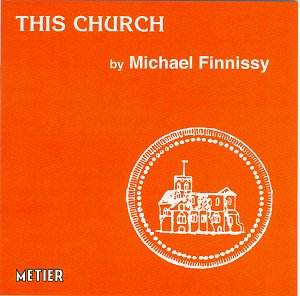One of the biggest challenges for any composer
is to compose for a combination of professionals and amateurs,
especially for the latter. With the former you are largely free
to express whatever you like in the knowledge that it can be done.
With the latter you have to be aware of many constraints. What
will be the rehearsal time. How many can read music? For voices
the melodic lines should ideally link with accompaniment and other
voices so that each entry is not too difficult to achieve. For
instrumentalists rhythms should be not overly complex. Yet one’s
own voice, one’s own integrity, must shine through. The composer
must express what he or she wants. These constraints can bring
the best out of some composers as it seemed to for Britten. Other
composers are unable compromise. Where does Michael Finnissy fall?
The present work was written to celebrate the
900th Anniversary of the church of Saint Mary de Haura
in New Shoreham, Sussex. If you are familiar with the town you
will know that it has two ancient and wonderful churches. There
is St. Nicholas Old Shoreham which has much Saxon work and St.Mary’s
founded by William de Braose, an associate of William 1st,
in the main town centre. This is a superb example of very early
Gothic architecture. The history of this coastal town, goes back
into the depths of British Christianity. This is represented in
Finnissy’s music.
This Church is scored for two (professional)
singers. The first is a mezzo-soprano who sings the interposed
German chorales. There is also a baritone soloist who sings, largely
unaccompanied monody. The sung texts concern the history and writings
about the church. There are two narrators. The organ is used as
is the parish choir of seventeen members who sing mostly in unison.
There is a group of extremely well drilled and competent hand
bell ringers and the ensemble Ixion with Finnissy himself at the
piano. Ixion are familiar with his music and have recorded several
of his works before. The present work last over an hour and is
divided into four tableaux. Incidentally the timings of each section
given on the box are completely wrong. It is quite extraordinary
that such an uncomplicated detail should be so inaccurate.
The beginning of the work is impressive. The
soprano’s eastern type ornamental chant of the Latin hymn ‘O clarissima
Mater’ over a choir drone and a series of tambourine shakes is
memorable. No-one can really know what Anglo-Saxon music was like
but for a moment one is easily transported back to a thousand
year old world until you remember a facet of Finnissy’s biography.
He was brought up with Polish friends and a refugee from Hungary.
He became interested in Eastern European culture and transcribed
tapes of Macedonian folk music. He has been inspired by the music
of Hungary and of the Rumanian gypsies. These sounds have been
a powerful part of his music since his twenties. Consequently
his language has become quite personal and original. It might
take some grasping at first, but with careful and unbiased listening,
it can be heard as beautiful and intricate. It is this sound-world
that one enters at the start of the piece.
This is an eclectic work and part 1 is a good
demonstration of it. I’ve already mentioned the opening. There
follows a baritone solo which relates factual detail concerning
the origins of the church. (The texts for all of the work are
quite diverse and their sources are carefully indexed at the back
of the booklet).The baritone is accompanied by a drone from an
accordion and there are choir interjections in Latin. A flute
enters with a quarter-tone melody and is joined by the baritone.
The organ enters gently in a style more akin to J.S. Bach. This
austere counterpoint presages a German chorale, a text used by
Bach. A string quartet joins in the counterpoint and then sopranos
of the choir. Bach is very close although some of the harmonies
are not quite ‘kosher’. The baritone then picks up a text about
the ‘desecration of the church during the reign of Edward VI’.
He is mostly accompanied by the occasional ejaculation, one may
say, from a racket.
Part 2 begins with typical wailing counterpoint
in piano, accordion and other wind. One hears similar sounds in
other Finnissy works such as Red Earth (NMC 0405). This
music accompanies spoken texts about Shoreham in the 17th
Century. And so it continues. I hope you get the idea. The texts
take us right into our own times. The piece ends with a poem by
George Herbert - most haunting. There is much here which is stylistically
disparate yet it somehow keeps its integrity and ‘hangs together’,
although I did occasionally get fed up with the acres of spoken
text at the beginning of Part 3.
I do not have any reservations about the performance
or the recording. Richard Jackson does sterling work especially
in the quite long recitations. Jane Money has a strong yet ethereal
voice. The choir are crisp, in tune and very well rehearsed but
perhaps they need a more forward placement in the overall sound
picture.
Full texts are given and there is an essay by
Michael Finnissy but it’s rather short and mainly concerns itself
with structure. On the other hand perhaps composers are too often
accused of prolixity.
To sum up then: a fascinating piece and one which
highlights an unusual facet of this, one of the most original
and prolific composers of our time.
Gary Higginson
